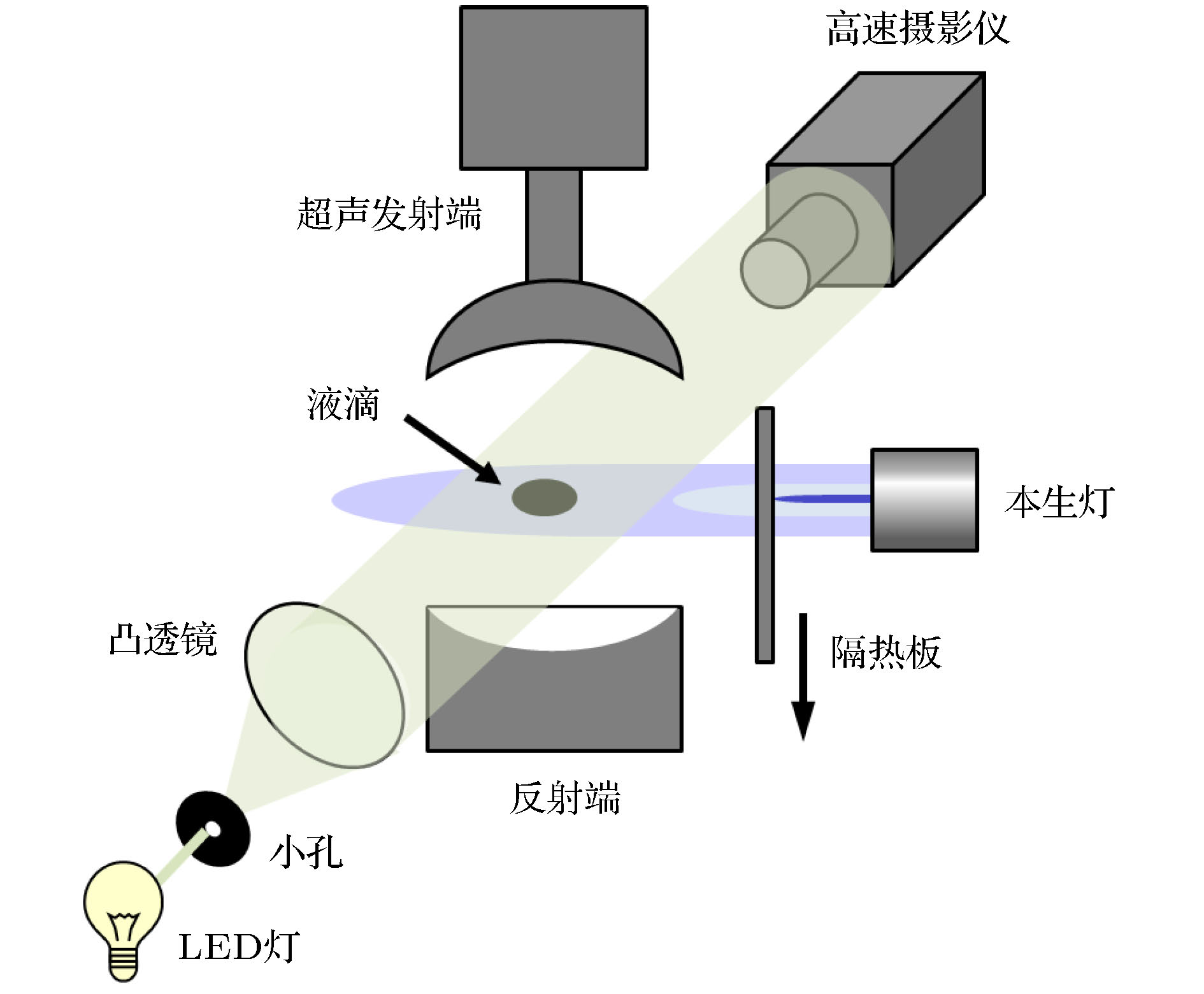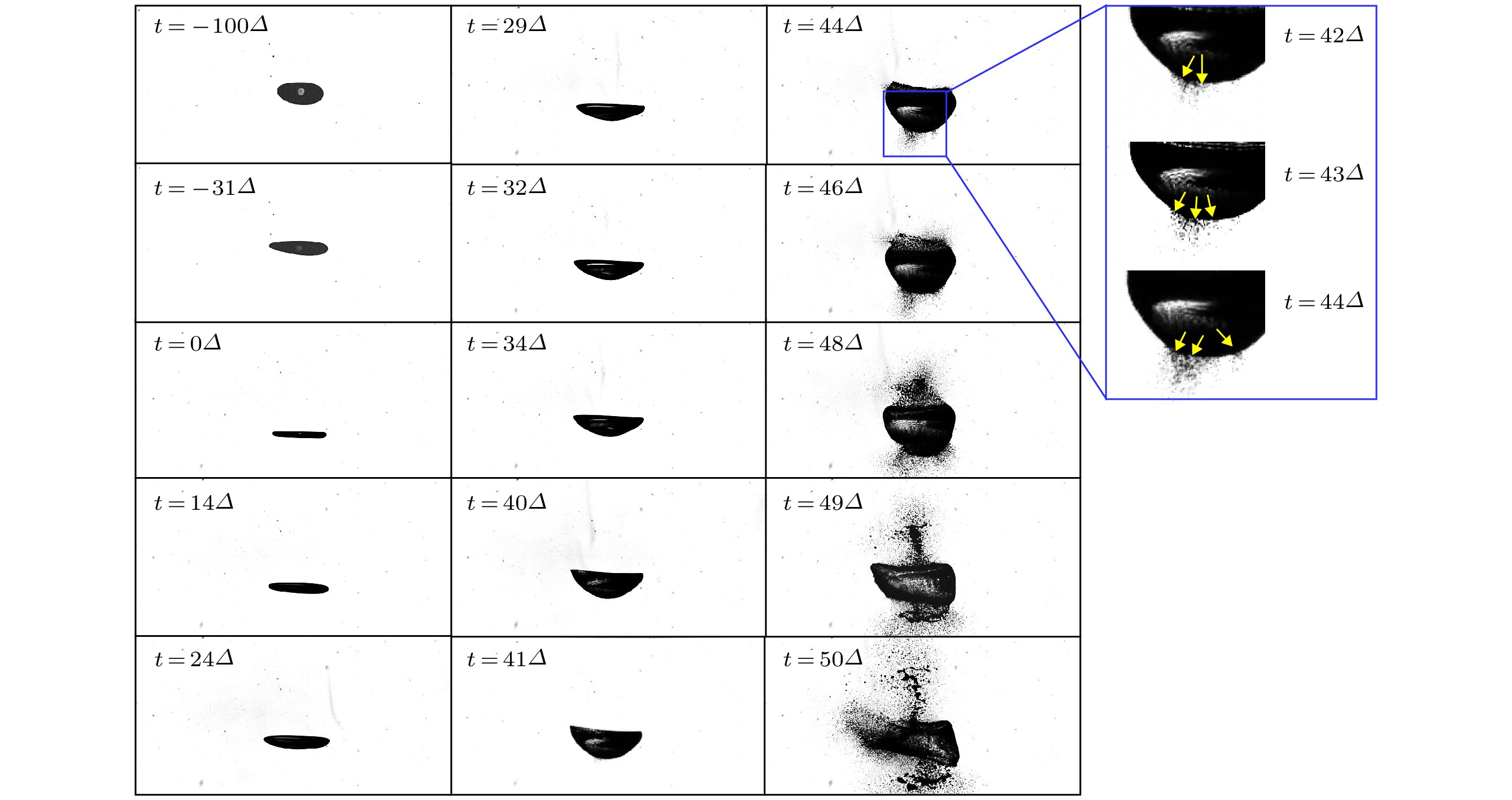-
采用外部高温气体加热的方式研究了超声悬浮甲醇液滴的声致破碎雾化现象, 利用高速摄像手段记录并实验研究了不同直径液滴不同的破碎雾化特性. 结果表明: 超声悬浮液滴在高温气流吹扫后可发生边缘喷射雾化现象. 破碎方式包含边缘溅射、液膜割裂和法向溅射三类. 直径D0较小的液滴直接从赤道面开始边缘溅射直至完全雾化; 等效直径D0 > 2.8 mm的液滴, 在产生边缘溅射后, 剩余液核弯曲形成液膜, 其表面产生法拉第波, 使得液膜割裂破碎; 而D0 > 3.2 mm的液滴, 在变形过程中逐渐形成“碗状”空腔, 并在其底部的法向方向产生溅射, 同时开始液膜割裂的离散化解体过程并伴随着边缘溅射, 直至完全雾化. 这种声致液滴雾化现象丰富了多物理场耦合作用下的流体理论, 可为相关应用研究提供新思路.
Atomization of droplets is ubiquitous in many natural and industrial processes, such as falling rain drops, inkjet printing, fuel injection in automotive and gas-turbine engines. Acoustic irradiation provides a very effective method of atomizing fluid. However, the acoustic atomization of acoustically levitated droplet is seldom studied. To assess the possibility of achieving ultrafine atomization, we, in this paper, systematically study the atomization of an acoustically levitated droplet placed in a hot gas of a flame. High speed camera is utilized to investigate the atomization characteristics of various droplets with diameters ranging from 0.5 mm to 3.5 mm. The experimental results show that the sound pressure of the resonance acoustic field has the ability to atomize the droplet when it is suddenly bathed in hot gas. Here the heating acts as a switch to convert the droplet surface from an acoustic isolator to conductor by heating the surface to strong evaporation. The presence of a high concentration of vapor molecules surrounding the droplet caused the acoustic field to change, thus, a much larger pressure gradient is established along the droplet surface, resulting in the atomization of droplet from the equator. Furthermore, Faraday wave stimulation and discretization on the film cause the droplet to further disintegrate when the droplet diameter is large enough. The atomization consists of three different styles, i.e. rim spray (RS), film disintegration (FD) and normal sputtering (NS). When exposed to hot gas, the droplets with equivalent diameter D0 < 2.8 mm are depleted with RS until the whole mass is atomization. A thin rim is extruded at the equator and then splashed in the equator plane, the spray speed is around 9.5 m/s. Larger droplets end with the sudden FD of liquid film of the residual mass after the the RS has been consumed up. When the thickness of the rim and buckled film decrease to half of wave length, Faraday wave emerges, resulting in the vertical droplet ejection and the disintegration of the thin films. And the droplets with D0 > 3.2 mm undergo further film buckling, forming a closed bubble due to the Helmholtz resonator effect and NS at the bottom. This sound driven atomization of droplets enriches the understanding of fluid mechanism in multi-physical fields, and may provide new ideas for relative application research. -
Keywords:
- acoustic levitation /
- droplet /
- external heating /
- atomization /
- methanol
[1] Villermaux E, Bossa B 2009 Nat. Phys. 5 697
 Google Scholar
Google Scholar
[2] Minemawari H, Yamada T, Matsui H, Tsutsumi J, Haas S, Chiba R, Kumai R, Hasegawa T 2011 Nature 475 364
 Google Scholar
Google Scholar
[3] Zhang Z, Liu H F, Zhang, F, Yao M F 2016 Appl. Therm. Eng. 95 1
 Google Scholar
Google Scholar
[4] Strotos G, Malgarinos I, Nikolopoulos N, Gavaises M, Nikasd K S, Moustrisd K 2018 Int. J. Heat Fluid Flow 69 164
 Google Scholar
Google Scholar
[5] Flock A K, Guildenbecher D R, Chen J, Sojka P E, Bauer H J 2012 Int. J. Multiphase Flow 47 37
 Google Scholar
Google Scholar
[6] Khojasteh D, Kazerooni N M, Marengo M 2019 J. Ind. Eng. Chem. 71 50
 Google Scholar
Google Scholar
[7] Gad H M, Ibrahim I A, Abdelbaky A F T, Abd El-samed A K, Farag T M 2018 Exp. Therm. Fluid Sci. 99 211
 Google Scholar
Google Scholar
[8] Goodridge C L, Hentschel H G E, Lathrop D P 1999 Phys. Rev. Lett. 82 3062
 Google Scholar
Google Scholar
[9] Brandt E H 2001 Nature 413 474
 Google Scholar
Google Scholar
[10] Yarin A L, Brenn G, Kastner O, Rensink D, Tropea C 1999 J. Fluid Mech. 399 151
 Google Scholar
Google Scholar
[11] Yarin A L, Pfaffenlehner M, Tropea C 1998 J. Fluid Mech. 356 65
 Google Scholar
Google Scholar
[12] Xie W J, Wei B 2001 Appl. Phys. Lett. 79 881
 Google Scholar
Google Scholar
[13] 杜人君, 解文军 2011 60 114302
 Google Scholar
Google Scholar
Du R J, Xie W J 2011 Acta Phys. Sin. 60 114302
 Google Scholar
Google Scholar
[14] Kooij S, Astefanei A, Corthals G L, Bonn D 2019 Sci. Rep. 9 6128
 Google Scholar
Google Scholar
[15] Friend J, Yeo L 2012 J. Acoust. Soc. Am. 131 3303
[16] Basu S, Saha A, Kumar R 2012 Appl. Phys. Lett. 100 054101
 Google Scholar
Google Scholar
[17] Pathak B, Basu S 2016 Phys. Fluids 28 123302
 Google Scholar
Google Scholar
[18] Zang D Y, Li L, Di W L, Zhang Z H, Ding C L, Chen C, Shen W, Binks B P, Geng X G 2018 Nat. Commun. 9 3546
 Google Scholar
Google Scholar
[19] Kinsler L E, Frey A R, Coppens H B 1983 Fundamentals of Acoustics (3rd Ed.) (New York: Wiley) pp233–259
[20] Opstal J V 2016 The Auditory System and Human Sound-Localization Behavior (Amsterdam: Elsevier) pp23–50
[21] Fu T, Mao Y J, Tang Y, Zhang Y W, Yuan W 2015 Nanoscale Microscale Thermophys. Eng. 19 17
 Google Scholar
Google Scholar
[22] Kudrolli A, Gollub J P 1996 Phys. Rev. E 54 1052
 Google Scholar
Google Scholar
[23] Donnelly T D, Hogan J, Mugler A, Schommer N, Schubmehl M, Bernoff A J, Forrest B 2004 Phys. Fluids 16 2843
 Google Scholar
Google Scholar
[24] Kelvin L, Thompson W 1871 Philos. Mag. 42 362
 Google Scholar
Google Scholar
[25] Rayleigh L 1883 Philos. Mag. 16 50
 Google Scholar
Google Scholar
[26] Cheng H, Zhao J Y, Wang J 2019 Int. J. Heat Mass Transfer 132 388
 Google Scholar
Google Scholar
[27] Ding C L, Chen H J, Zhai S L, Liu S, Zhao X P 2015 J. Phys. D 48 045303
 Google Scholar
Google Scholar
-
图 3 甲醇液滴溅射时的参数描述 (a) 扩散直径; (b) 无量纲液核直径; (c) 赤道处曲率半径; (d) 气液界面在室温和强蒸发时的液体与空气分子分布[21]
Fig. 3. Parametrical description of the breaking process: (a) Spreading diameter Ds; (b) the dimensionless diameter Dc of liquid core; (c) equatorial curvature radii Rcav vs. time; (d) liquid and air molecule distribution at the interface at ambient temperature and strong evaporation conditions[21].
-
[1] Villermaux E, Bossa B 2009 Nat. Phys. 5 697
 Google Scholar
Google Scholar
[2] Minemawari H, Yamada T, Matsui H, Tsutsumi J, Haas S, Chiba R, Kumai R, Hasegawa T 2011 Nature 475 364
 Google Scholar
Google Scholar
[3] Zhang Z, Liu H F, Zhang, F, Yao M F 2016 Appl. Therm. Eng. 95 1
 Google Scholar
Google Scholar
[4] Strotos G, Malgarinos I, Nikolopoulos N, Gavaises M, Nikasd K S, Moustrisd K 2018 Int. J. Heat Fluid Flow 69 164
 Google Scholar
Google Scholar
[5] Flock A K, Guildenbecher D R, Chen J, Sojka P E, Bauer H J 2012 Int. J. Multiphase Flow 47 37
 Google Scholar
Google Scholar
[6] Khojasteh D, Kazerooni N M, Marengo M 2019 J. Ind. Eng. Chem. 71 50
 Google Scholar
Google Scholar
[7] Gad H M, Ibrahim I A, Abdelbaky A F T, Abd El-samed A K, Farag T M 2018 Exp. Therm. Fluid Sci. 99 211
 Google Scholar
Google Scholar
[8] Goodridge C L, Hentschel H G E, Lathrop D P 1999 Phys. Rev. Lett. 82 3062
 Google Scholar
Google Scholar
[9] Brandt E H 2001 Nature 413 474
 Google Scholar
Google Scholar
[10] Yarin A L, Brenn G, Kastner O, Rensink D, Tropea C 1999 J. Fluid Mech. 399 151
 Google Scholar
Google Scholar
[11] Yarin A L, Pfaffenlehner M, Tropea C 1998 J. Fluid Mech. 356 65
 Google Scholar
Google Scholar
[12] Xie W J, Wei B 2001 Appl. Phys. Lett. 79 881
 Google Scholar
Google Scholar
[13] 杜人君, 解文军 2011 60 114302
 Google Scholar
Google Scholar
Du R J, Xie W J 2011 Acta Phys. Sin. 60 114302
 Google Scholar
Google Scholar
[14] Kooij S, Astefanei A, Corthals G L, Bonn D 2019 Sci. Rep. 9 6128
 Google Scholar
Google Scholar
[15] Friend J, Yeo L 2012 J. Acoust. Soc. Am. 131 3303
[16] Basu S, Saha A, Kumar R 2012 Appl. Phys. Lett. 100 054101
 Google Scholar
Google Scholar
[17] Pathak B, Basu S 2016 Phys. Fluids 28 123302
 Google Scholar
Google Scholar
[18] Zang D Y, Li L, Di W L, Zhang Z H, Ding C L, Chen C, Shen W, Binks B P, Geng X G 2018 Nat. Commun. 9 3546
 Google Scholar
Google Scholar
[19] Kinsler L E, Frey A R, Coppens H B 1983 Fundamentals of Acoustics (3rd Ed.) (New York: Wiley) pp233–259
[20] Opstal J V 2016 The Auditory System and Human Sound-Localization Behavior (Amsterdam: Elsevier) pp23–50
[21] Fu T, Mao Y J, Tang Y, Zhang Y W, Yuan W 2015 Nanoscale Microscale Thermophys. Eng. 19 17
 Google Scholar
Google Scholar
[22] Kudrolli A, Gollub J P 1996 Phys. Rev. E 54 1052
 Google Scholar
Google Scholar
[23] Donnelly T D, Hogan J, Mugler A, Schommer N, Schubmehl M, Bernoff A J, Forrest B 2004 Phys. Fluids 16 2843
 Google Scholar
Google Scholar
[24] Kelvin L, Thompson W 1871 Philos. Mag. 42 362
 Google Scholar
Google Scholar
[25] Rayleigh L 1883 Philos. Mag. 16 50
 Google Scholar
Google Scholar
[26] Cheng H, Zhao J Y, Wang J 2019 Int. J. Heat Mass Transfer 132 388
 Google Scholar
Google Scholar
[27] Ding C L, Chen H J, Zhai S L, Liu S, Zhao X P 2015 J. Phys. D 48 045303
 Google Scholar
Google Scholar
计量
- 文章访问数: 11992
- PDF下载量: 144
- 被引次数: 0














 下载:
下载:






